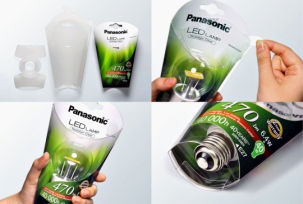Archive
Want vs. Need
How many times have you found yourself staring at something and realizing that you want it? You want it so bad that you can taste it and feel that getting it is the best thing for you.
And suddenly, you realize that it isn’t what you really need. Not that what you need isn’t sexy and appealing – just that what you need is really what you need. Period. And acting on that realization is half the battle.
Acquiring the right packaging needs for your product is key to connecting your brand message to the right audience. It lets them know that you understand what they want and what they need.
Does your packaging company listen to your wants and distill them into what you need thus allowing you to see both sides of the want vs. need equation?
After all, isn’t that what you really want?
To learn more, go to www.ctipack.com
What’s New In Blisters and Clamshells Part 3
Here is the third and final segment of this post and many thanks to my friend Anton Steeman at http://bestinpackaging.com/ for letting us push this out to all of you.
 Clamshell for fruit with ripeness indicator
Clamshell for fruit with ripeness indicator
Declining global consumption of fresh fruit and vegetables has been concerning health professionals and produce trade leaders for some time. Convenience and taste have been identified as key drivers to encourage increased consumption. The RipeSense label can be expected to change the way shoppers buy fruit by showing the exact level of ripeness without handling or guesswork.
The clamshell pack, moulded to the shape of the pears, was developed to trap the aroma necessary for the ripeSense label to function, while the key reason for developing ripeSense for pears is the difficulty shoppers have determining fruit ripeness.
Pears, unlike apples, need to soften before they achieve their maximum flavour and shoppers often squeeze and damage the fruit as they make their selection. The clamshell protects the pears from crushing and bruising, permitting retailers to sell tender juicy ripe fruit without wastage.
The ripeSense sensor label is world-first technology that enables shoppers to choose fruit that best appeals to their taste. It works by detecting aroma compounds given off the fruit as it ripens, changing the label through a range of colours.
Shoppers can choose to either buy pears that are ready to eat immediately or they can purchase firmer fruit that will be ready for eating in a few days. Further research is proposed to develop sensor labels for summer fruit, kiwifruit, avocado and melons. The new label technology is the result of five years development by HortResearch scientists, funded largely by the New Zealand Foundation for Research, Science and Technology.
It belongs in the section of intelligent packaging that changes colour to indicate the ripeness of fruit. Developed in New Zealand, ripeSense packaging technology is expected to bring significant efficiencies to the fresh fruit industry, reducing wastage and forever eradicating the old selling process of selling loose, usually unripe, fruit into bins, where it is bruised, squeezed and prodded to determine its ripeness.
To learn more, go to www.ctipack.com
What’s New In Blisters and Clamshells Part 2
Today we continue with Part 2.
 LED light bulb packaging
LED light bulb packaging
Akihiko Kotani and Mitsutoshi Ohta designers in Tokyo, Japan, created for Panasonic Corporation in Osaka, Japan, a LED light bulb packaging with a paper craft-like structure.
The packaging can just be folded without the need for heat moulding. The packaging simply divides into transparent PET plastic and cardboard, which makes for easy disposal of the separated components. And because there is no printing on the case, there are no impurities such as ink to deal with, which makes recycling easier.
The one-touch pinch-and-pull opening allows the consumer to extract the products easily. The packaging is shaped to fit well in the hand, and checking what is inside through the packaging is easy. Particular consideration has been given to prevent incorrect purchases by enabling customers to touch and check the metal caps.
Lamps are a hot item in terms of clamshells and blister packaging. Besides Panasonic, Brazilian designers also created a workable alternative.
FLC Sustainable fluorescent lamp packaging
Despite its characteristics such as greater energy efficiency and life expectancy in comparison to incandescent lamps, fluorescent lamps contain toxic residues which may contaminate the environment in case of inappropriate discard or accidents regarding its handling and transportation.
 For a college project executed for FLC, a Brazilian fluorescent lamp company, Guilherme Parolin, and Fabrício Vaz, both students at the UFRGS – Universidade Federal do Rio Grande do Sul in Porto Alegre/Brazil, designed a packaging for a fluorescent lamp.
For a college project executed for FLC, a Brazilian fluorescent lamp company, Guilherme Parolin, and Fabrício Vaz, both students at the UFRGS – Universidade Federal do Rio Grande do Sul in Porto Alegre/Brazil, designed a packaging for a fluorescent lamp.
The FLC sustainable packaging, beyond a mere packaging, proposes a new kind of relationship between the consumer and the fluorescent lamp by facilitating the return of the replaced, old or damaged bulb to its manufacturer and its due recycling.
The package, composed mainly from moulded paper pulp, offers an efficient protection of the new lamp from the point of sale to its place of use, and acts, in its second life, as a protective case for the inoperative lamp, which can therefore be discarded safely in domestic waste or forwarded to a proper waste collection point.
Moulded ribs and latches inside the packaging ensure a correct positioning and fixing of the lamp against possible impacts. The hexagonal shape offers greater stability and better use of space at the point of sale. The sleeve, made from recycled paper provides the relevant information to the consumer in a hierarchical way.
Although the designers claim that its major innovation is the use of moulded paper pulp, in the same way as for egg packaging, to ensure the protection and safety of the lamp, the result is a “blind” packaging. The consumer can’t see the product.
To create a positive visual impact it would be interesting to execute this packaging in a thermoformable recyclable plastic film, which would allow for a consumer-friendly clamshell by its longitudinal opening and the use of the reliefs for a better ergonomic performance.
Stay tuned for the next post to read about an interesting food label.
Learn more at http://www.ctipack.com

